Integrated Transcriptomic and Un-Targeted Metabolomics Analysis Reveals Mulberry Fruit (Morus atropurpurea) in Response to Sclerotiniose Pathogen Ciboria shiraiana Infection
Abstract
1. Introduction
2. Results
2.1. Symptoms of Infected Mulberry Fruits and Fungal Detection
2.2. Identified Differentially Expressed Genes (DEGs), Their Gene Ontology (GO) Enrichments, and Kyoto Encyclopedia of Genes and Genomes (KEGG) Enrichments by Transcriptome Analysis
2.3. Transcriptomic Response of Mulberry Fruits Infected by C. shiraiana
2.3.1. Plant Hormone Signal Transduction Pathway
2.3.2. Phenylpropanoid Biosynthesis Pathway
2.3.3. Transcription Factors
2.4. Overview of the Metabolites in the Phenylpropanoid Pathway by Metabolimics Data
3. Discussion
4. Materials and Methods
4.1. Plant Growth Conditions and Fungus Identification
4.2. Pathogen Detection and Enzyme Activity Analysis
4.3. Tissue Paraffin Section and Fluorescent Staning
4.4. RNA Extraction, RNA Sequencing, and Functional Annotations
4.5. Validation of Gene Expression by Quantitative Real-Time PCR (qRT-PCR)
4.6. Metabolite Profiling Assay by Ultra-Performance Liquid Chromatography (UPLC) and Mass Spectrometry (MS)
4.7. Metabolite Data Processing and Analysis
4.8. Mapman Analysis
Supplementary Materials
Author Contributions
Funding
Conflicts of Interest
References
- Mahboubi, M. Morus alba (mulberry), a natural potent compound in management of obesity. Pharmacol. Res. 2019, 146, 104341. [Google Scholar] [CrossRef] [PubMed]
- Zhang, H.; Ma, Z.F.; Luo, X.; Li, X.-L. Effects of Mulberry Fruit (Morus alba L.) Consumption on Health Outcomes: A Mini-Review. Antioxidants 2018, 7, 69. [Google Scholar] [CrossRef] [PubMed]
- Martinelli, F.; Uratsu, S.L.; Albrecht, U.; Reagan, R.L.; Phu, M.L.; Britton, M.; Buffalo, V.; Fass, J.; Leicht, E.; Zhao, W.; et al. Transcriptome Profiling of Citrus Fruit Response to Huanglongbing Disease. PLoS ONE 2012, 7, e38039. [Google Scholar] [CrossRef] [PubMed]
- Lu, R.; Zhao, A.; Li, J.; Wang, X.; Yu, Y.; Lu, C.; Yu, M. Biological study of hypertrophy sorosis scleroteniosis and its molecular characterization based on LSU rRNA. Afr. J. Microbiol. Res. 2013, 7, 3405–3411. [Google Scholar]
- Lu, R.; Zhao, A.; Li, J.; Liu, C.; Wang, C.; Wang, X.; Wang, X.; Pei, R.; Lu, C.; Yu, M. Screening, cloning and expression analysis of a cellulase derived from the causative agent of hypertrophy sorosis scleroteniosis, Ciboria shiraiana. Gene 2015, 565, 221–227. [Google Scholar] [CrossRef] [PubMed]
- Li, M.; Lu, R.; Yu, J.; Cai, Y.; Wang, C.; Zhao, A.; Lu, C.; Yu, M. Cloning and Functional Analysis of Polygalacturonase Genes from Ciboria shiraiana. Acta Agron. Sin. 2016, 42, 190. [Google Scholar] [CrossRef]
- Rudd, J.J.; Kanyuka, K.; Hassani-Pak, K.; Derbyshire, M.C.; Andongabo, A.; Devonshire, J.; Lysenko, A.; Saqi, M.; Desai, N.M.; Powers, S.J.; et al. Transcriptome and metabolite profiling of the infection cycle of Zymoseptoria tritici on wheat reveals a biphasic interaction with plant immunity involving differential pathogen chromosomal contributions and a variation on the hemibiotrophic lifestyle definition. Plant Physiol. 2015, 167, 1158–1185. [Google Scholar]
- Schmidt, R.; Durling, M.B.; De Jager, V.; Menezes, R.C.; Nordkvist, E.; Svatos, A.; Dubey, M.; Lauterbach, L.; Dickschat, J.S.; Karlsson, M.; et al. Deciphering the genome and secondary metabolome of the plant pathogen Fusarium culmorum. FEMS Microbiol. Ecol. 2018, 94. [Google Scholar] [CrossRef]
- Liu, X.; Cao, X.; Shi, S.; Zhao, N.; Li, D.; Fang, P.; Chen, X.; Qi, W.; Zhang, Z. Comparative RNA-Seq analysis reveals a critical role for brassinosteroids in rose (Rosa hybrida) petal defense against Botrytis cinerea infection. BMC Genet. 2018, 19, 62. [Google Scholar] [CrossRef] [PubMed]
- Lardi, M.; Murset, V.; Fischer, H.-M.; Mesa, S.; Ahrens, C.H.; Zamboni, N.; Pessi, G. Metabolomic Profiling of Bradyrhizobium diazoefficiens-Induced Root Nodules Reveals Both Host Plant-Specific and Developmental Signatures. Int. J. Mol. Sci. 2016, 17, 815. [Google Scholar] [CrossRef]
- Yao, L.; Yu, Q.; Huang, M.; Hung, W.; Grosser, J.; Chen, S.; Wang, Y.; Gmitter, F.G. Proteomic and metabolomic analyses provide insight into the off-flavour of fruits from citrus trees infected with ‘Candidatus Liberibacter asiaticus’. Hortic. Res. 2019, 6, 31. [Google Scholar] [CrossRef] [PubMed]
- Wang, C.; Tariq, R.; Ji, Z.; Wei, Z.; Zheng, K.; Mishra, R.; Zhao, K. Transcriptome analysis of a rice cultivar reveals the differentially expressed genes in response to wild and mutant strains of Xanthomonas oryzae pv. oryzae. Sci. Rep. 2019, 9, 3757. [Google Scholar] [CrossRef] [PubMed]
- Liu, D.; Zhao, Q.; Cheng, Y.; Li, D.; Jiang, C.; Cheng, L.; Wang, Y.; Yang, A. Transcriptome analysis of two cultivars of tobacco in response to Cucumber mosaic virus infection. Sci. Rep. 2019, 9, 3124. [Google Scholar] [CrossRef] [PubMed]
- He, N.; Zhang, C.; Qi, X.; Zhao, S.; Tao, Y.; Yang, G.; Lee, T.-H.; Wang, X.; Cai, Q.; Li, N.; et al. Draft genome sequence of the mulberry tree Morus notabilis. Nat. Commun. 2013, 4, 2445. [Google Scholar] [CrossRef] [PubMed]
- Dai, F.; Wang, Z.; Li, Z.; Luo, G.; Wang, Y.; Tang, C. Transcriptomic and proteomic analyses of mulberry (Morus atropurpurea) fruit response to Ciboria carunculoides. J. Proteom. 2019, 193, 142–153. [Google Scholar] [CrossRef] [PubMed]
- Yin, P.; Li, X.; Zeng, Q.; Shen, C.; Gao, L.; Ton, J. Effect of Popcorn Disease Infected Leaves on Silkworm Performance and Differential Proteome Analysis of Mulberry Popcorn Disease. Pak. J. Zool. 2017, 50. [Google Scholar] [CrossRef]
- Dodds, P.N.; Rathjen, J.P. Plant immunity: Towards an integrated view of plant–pathogen interactions. Nat. Rev. Genet. 2010, 11, 539–548. [Google Scholar] [CrossRef]
- Windram, O.P.F.; Penfold, C.; Denby, K. Network Modeling to Understand Plant Immunity. Annu. Rev. Phytopathol. 2014, 52, 93–111. [Google Scholar] [CrossRef]
- Thimm, O.; Nagel, A.; Kruger, P.; Selbig, J.; Müller, L.A.; Bläsing, O.; Gibon, Y.; Meyer, S.; Rhee, S.Y.; Stitt, M. mapman: A user-driven tool to display genomics data sets onto diagrams of metabolic pathways and other biological processes. Plant J. 2004, 37, 914–939. [Google Scholar] [CrossRef]
- Pieterse, C.M.; Van Der Does, D.; Zamioudis, C.; Leon-Reyes, A.; Van Wees, S.C.M. Hormonal Modulation of Plant Immunity. Annu. Rev. Cell Dev. Boil. 2012, 28, 489–521. [Google Scholar] [CrossRef]
- Bari, R.; Jones, A. Role of plant hormones in plant defence responses. Plant Mol. Boil. 2008, 69, 473–488. [Google Scholar] [CrossRef] [PubMed]
- Blázquez, M.A.; Nelson, D.C.; Weijers, D. Evolution of Plant Hormone Response Pathways. Annu. Rev. Plant Boil. 2020, 71. [Google Scholar] [CrossRef] [PubMed]
- Chanclud, E.; Morel, J.-B. Plant hormones: A fungal point of view. Mol. Plant Pathol. 2016, 17, 1289–1297. [Google Scholar] [CrossRef] [PubMed]
- Luo, J.; Xia, W.; Cao, P.; Xiao, Z.; Zhang, Y.; Liu, M.; Zhan, C.; Wang, N. Integrated Transcriptome Analysis Reveals Plant Hormones Jasmonic Acid and Salicylic Acid Coordinate Growth and Defense Responses upon Fungal Infection in Poplar. Biomolecules 2019, 9, 12. [Google Scholar] [CrossRef] [PubMed]
- Castro-Moretti, F.R.; Gentzel, I.N.; Mackey, D.M.; Alonso, A.P. Metabolomics as an Emerging Tool for the Study of Plant–Pathogen Interactions. Metabolites 2020, 10, 52. [Google Scholar] [CrossRef] [PubMed]
- Liu, Y.; Ji, D.; Turgeon, R.; Chen, J.; Lin, T.; Huang, J.; Luo, J.; Zhu, Y.; Zhang, C.; Lv, Z. Physiological and Proteomic Responses of Mulberry Trees (Morus alba. L.) to Combined Salt and Drought Stress. Int. J. Mol. Sci. 2019, 20, 2486. [Google Scholar] [CrossRef]
- Zheng, Y.; Wang, P.; Chen, X.; Sun, Y.; Yue, C.; Ye, N. Transcriptome and Metabolite Profiling Reveal Novel Insights into Volatile Heterosis in the Tea Plant (Camellia sinensis). Molecules 2019, 24, 3380. [Google Scholar] [CrossRef]
- Zhai, R.; Wang, Z.; Zhang, S.; Meng, G.; Song, L.; Wang, Z.; Li, P.; Ma, F.; Xu, L. Two MYB transcription factors regulate flavonoid biosynthesis in pear fruit (Pyrus bretschneideri Rehd.). J. Exp. Bot. 2015, 67, 1275–1284. [Google Scholar] [CrossRef]
- Hichri, I.; Heppel, S.C.; Pillet, J.; Léon, C.; Czemmel, S.; Delrot, S.; Lauvergeat, V.; Bogs, J. The Basic Helix-Loop-Helix Transcription Factor MYC1 Is Involved in the Regulation of the Flavonoid Biosynthesis Pathway in Grapevine. Mol. Plant 2010, 3, 509–523. [Google Scholar] [CrossRef]
- Parker, D.; Beckmann, M.; Zubair, H.; Enot, D.P.; Overy, D.P.; Snowdon, S.; Talbot, N.J.; Draper, J.; Caracuel-Rios, Z. Metabolomic analysis reveals a common pattern of metabolic re-programming during invasion of three host plant species by Magnaporthe grisea. Plant J. 2009, 59, 723–737. [Google Scholar] [CrossRef]
- Robison, F.M.; Turner, M.F.; Jahn, C.; Schwartz, H.F.; Prenni, J.; Brick, M.; Heuberger, A.L. Common bean varieties demonstrate differential physiological and metabolic responses to the pathogenic fungus Sclerotinia sclerotiorum. Plant Cell Environ. 2018, 41, 2141–2154. [Google Scholar] [CrossRef] [PubMed]
- Rodríguez, A.; Shimada, T.; Cervera, M.; Alquezar, B.; Gadea, J.; Gómez-Cadenas, A.; De Ollas, C.; Rodrigo, M.J.; Zacarias, L.; Peña, L. Terpene Down-Regulation Triggers Defense Responses in Transgenic Orange Leading to Resistance against Fungal Pathogens1[W]. Plant Physiol. 2013, 164, 321–339. [Google Scholar] [CrossRef] [PubMed]
- Chen, F.; Ma, R.; Chen, X.-L. Advances of Metabolomics in Fungal Pathogen-Plant Interactions. Metabolites 2019, 9, 169. [Google Scholar] [CrossRef] [PubMed]
- Choo, T.M. Breeding Barley for Resistance to Fusarium Head Blight and Mycotoxin Accumulation. Plant Breed. Rev. 2010, 125–169. [Google Scholar]
- Ranjan, A.; Westrick, N.M.; Jain, S.; Piotrowski, J.S.; Ranjan, M.; Kessens, R.; Stiegman, L.; Grau, C.R.; Conley, S.P.; Smith, D.; et al. Resistance against Sclerotinia sclerotiorum in soybean involves a reprogramming of the phenylpropanoid pathway and up-regulation of antifungal activity targeting ergosterol biosynthesis. Plant Biotechnol. J. 2019, 17, 1567–1581. [Google Scholar] [CrossRef] [PubMed]
- Kovalchuk, A.; Zeng, Z.; Ghimire, R.P.; Kivimäenpää, M.; Raffaello, T.; Liu, M.; Mukrimin, M.; Kasanen, R.; Sun, H.; Julkunen-Tiitto, R.; et al. Dual RNA-seq analysis provides new insights into interactions between Norway spruce and necrotrophic pathogen Heterobasidion annosum s.l. BMC Plant Boil. 2019, 19, 2. [Google Scholar] [CrossRef] [PubMed]
- Rodrigues, E.L.; Marcelino, G.; Silva, G.T.; Figueiredo, P.S.; Garcez, W.S.; Corsino, J.; Guimarães, R.D.C.A.; Gielow, K.D.C.F. Nutraceutical and Medicinal Potential of the Morus Species in Metabolic Dysfunctions. Int. J. Mol. Sci. 2019, 20, 301. [Google Scholar] [CrossRef]
- Gui, Z.; Raman, S.T.; Ganeshan, A.K.P.G.; Chen, C.; Jin, C.; Li, S.-H.; Chen, H.-J. In vitro and In vivo antioxidant activity of flavonoid extracted from mulberry fruit (Morus alba L.). Pharmacogn. Mag. 2016, 12, 128–133. [Google Scholar] [CrossRef]
- Tu, J.; Shi, D.; Wen, L.; Jiang, Y.; Zhao, Y.; Yang, J.; Liu, H.; Liu, G.; Yang, B. Identification of moracin N in mulberry leaf and evaluation of antioxidant activity. Food Chem. Toxicol. 2019, 132, 110730. [Google Scholar] [CrossRef]
- Jiang, Y. Effects of anthocyanins derived from Xinjiang black mulberry fruit on delaying aging. J. Hyg. Res. 2010, 39. [Google Scholar]
- Qian, W.; Sun, Z.; Wang, T.; Yang, M.; Liu, M.; Zhang, J.; Li, Y. Antimicrobial activity of eugenol against carbapenem-resistant Klebsiella pneumoniae and its effect on biofilms. Microb. Pathog. 2020, 139, 103924. [Google Scholar] [CrossRef] [PubMed]
- Ju, J.; Xie, Y.; Yu, H.; Guo, Y.; Cheng, Y.; Zhang, R.; Yao, W. Synergistic inhibition effect of citral and eugenol against Aspergillus niger and their application in bread preservation. Food Chem. 2019, 310, 125974. [Google Scholar] [CrossRef] [PubMed]
- Xue, Y.; Zhou, S.; Fan, C.; Du, Q.; Jin, P. Enhanced Antifungal Activities of Eugenol-Entrapped Casein Nanoparticles against Anthracnose in Postharvest Fruits. Nanomaterials 2019, 9, 1777. [Google Scholar] [CrossRef] [PubMed]
- Rasconi, S.; Jobard, M.; Jouve, L.; Sime-Ngando, T. Use of Calcofluor White for Detection, Identification, and Quantification of Phytoplanktonic Fungal Parasites. Appl. Environ. Microbiol. 2009, 75, 2545–2553. [Google Scholar] [CrossRef] [PubMed]
- Cock, P.J.; Fields, C.J.; Goto, N.; Heuer, M.L.; Rice, P.M. The Sanger FASTQ file format for sequences with quality scores, and the Solexa/Illumina FASTQ variants. Nucleic Acids Res. 2009, 38, 1767–1771. [Google Scholar] [CrossRef] [PubMed]
- Kim, D.; Langmead, B.; Salzberg, S.L. HISAT: A fast spliced aligner with low memory requirements. Nat. Methods 2015, 12, 357–360. [Google Scholar] [CrossRef]
- Miao, L.; Di, Q.; Sun, T.; Li, Y.; Duan, Y.; Wang, J.; Yan, Y.; He, C.; Wang, C.; Yu, X. Integrated Metabolome and Transcriptome Analysis Provide Insights into the Effects of Grafting on Fruit Flavor of Cucumber with Different Rootstocks. Int. J. Mol. Sci. 2019, 20, 3592. [Google Scholar] [CrossRef]
- Wen, B.; Mei, Z.; Zeng, C.; Liu, S. metaX: A flexible and comprehensive software for processing metabolomics data. BMC Bioinform. 2017, 18, 183. [Google Scholar] [CrossRef]

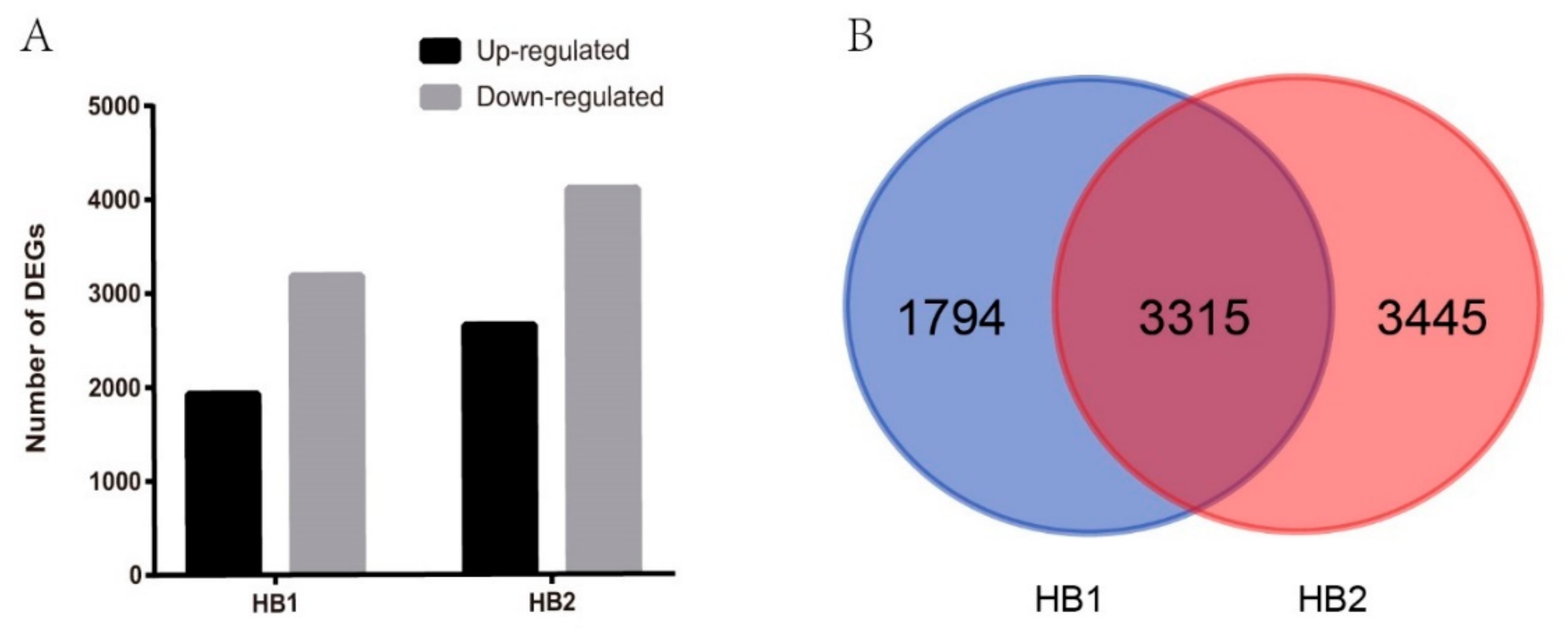
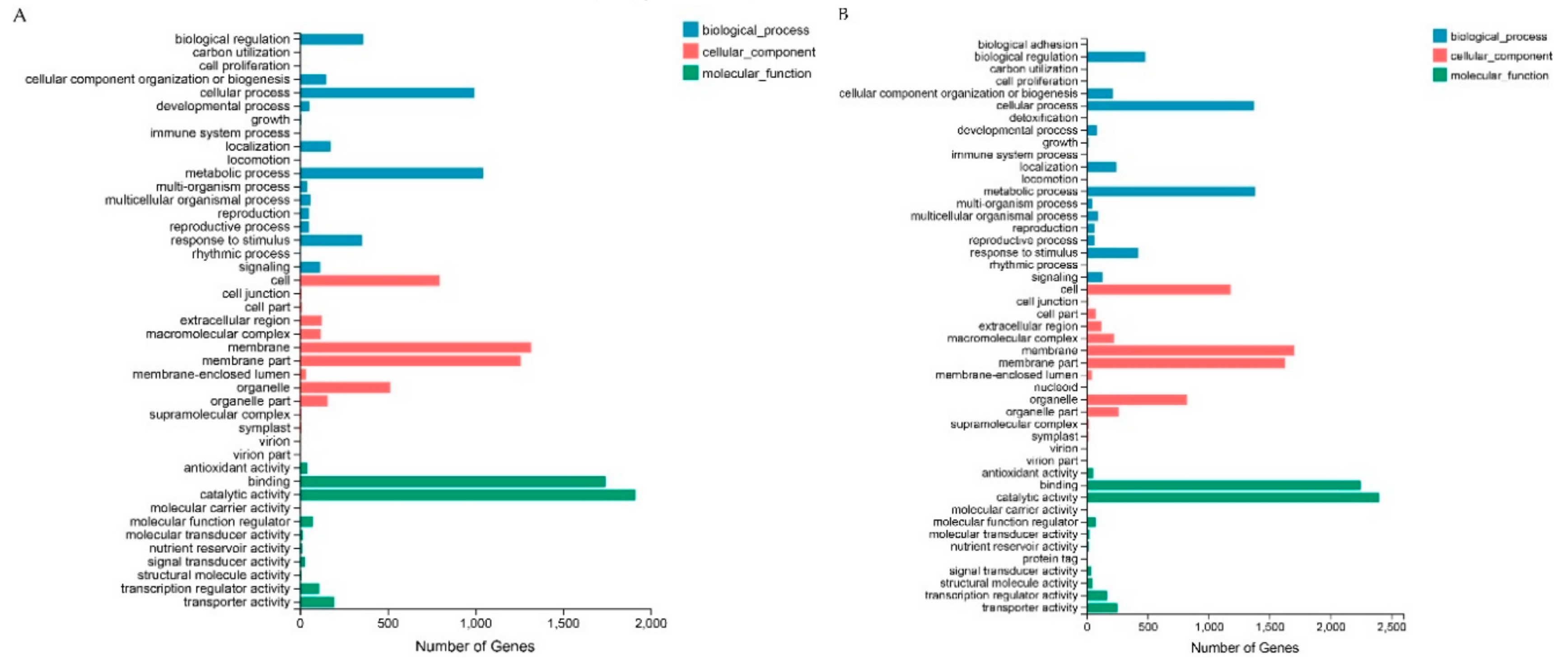
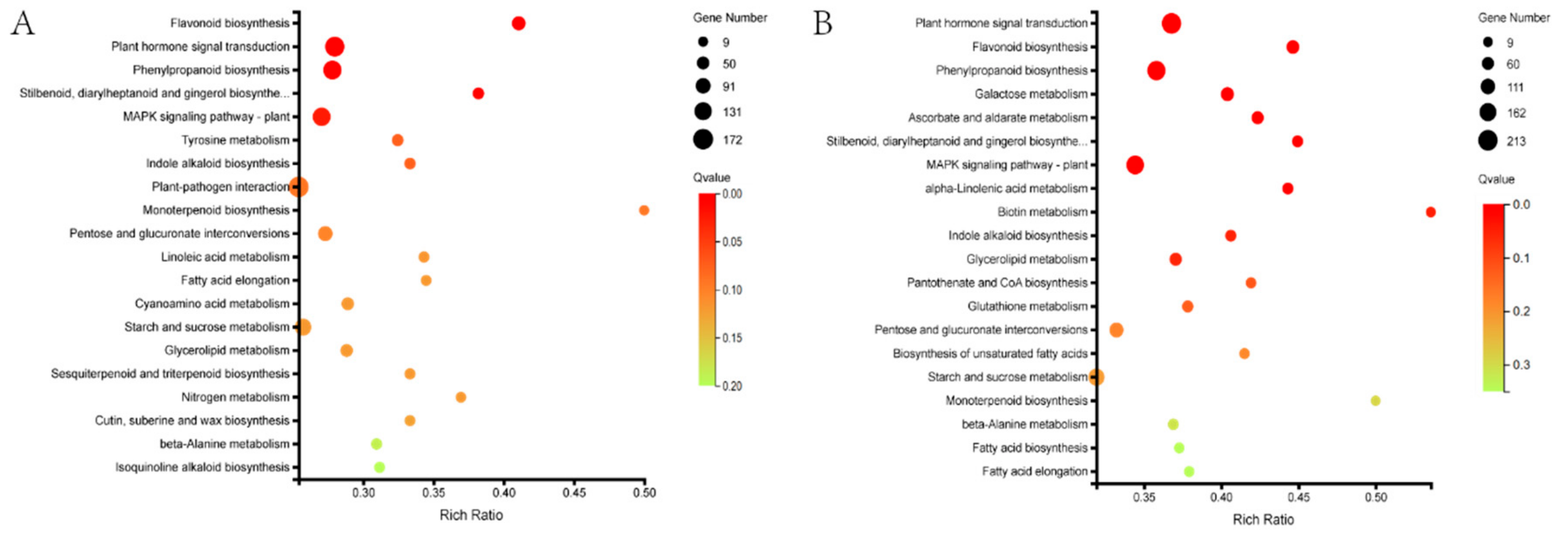
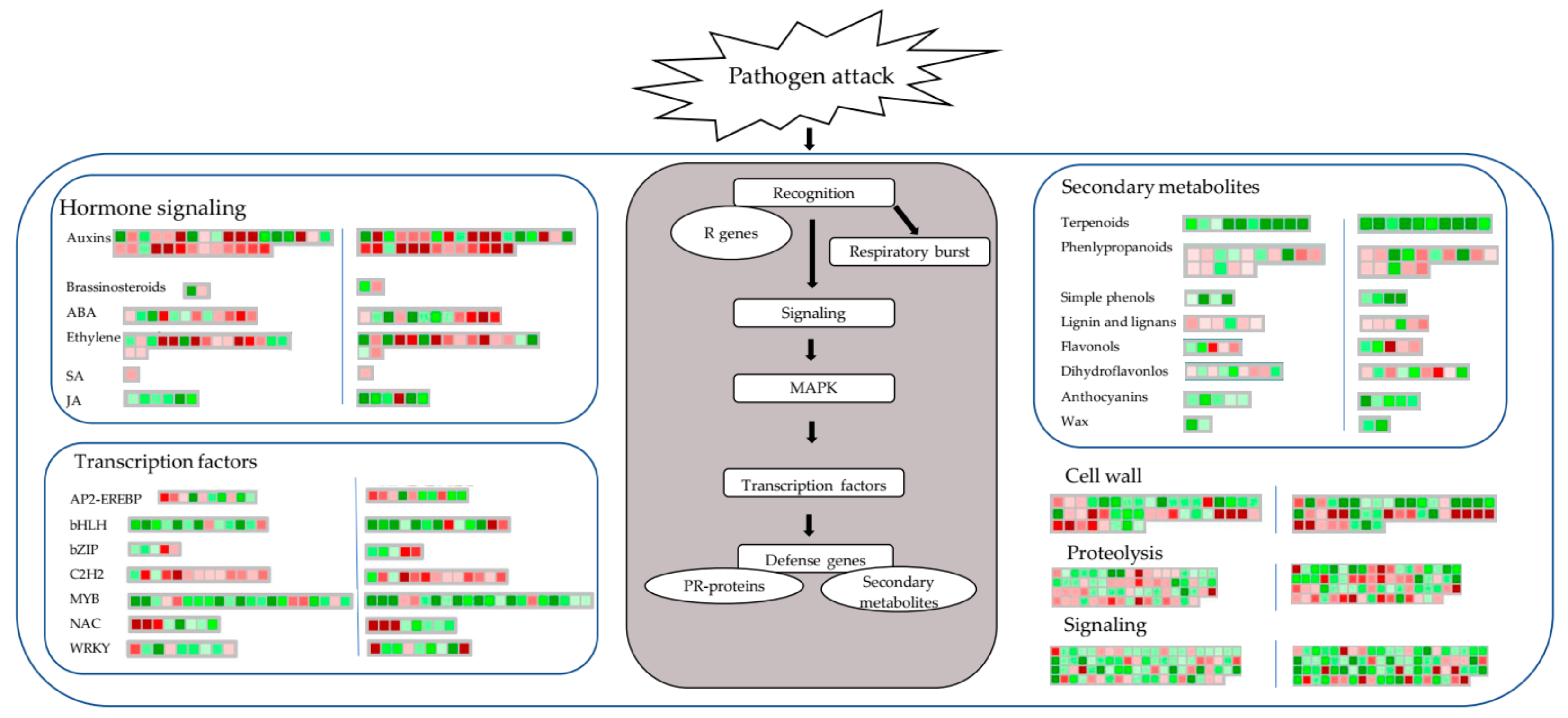
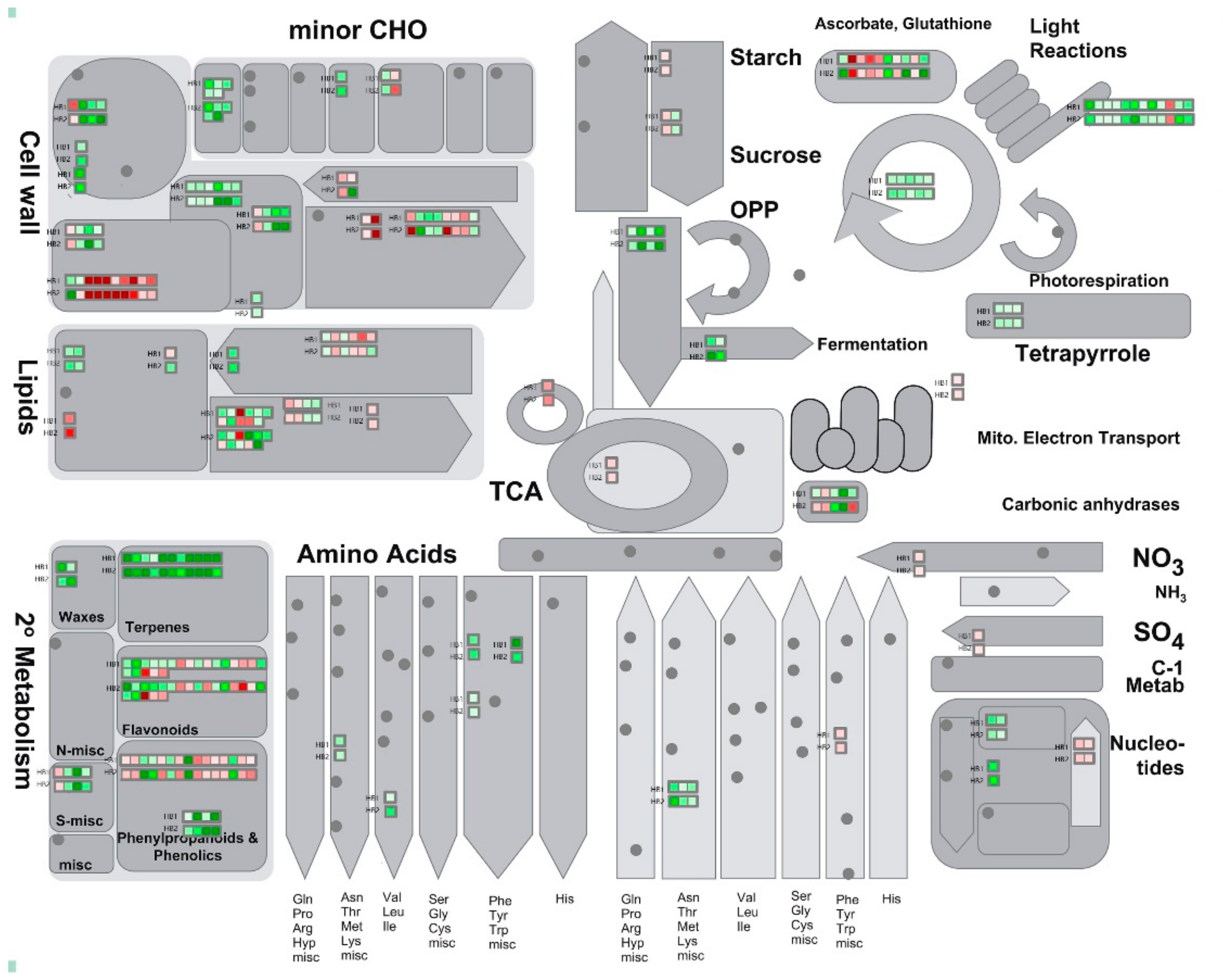

| Gene ID | Predicted Gene Description | Gene Expression (log2 Ratio) | |
|---|---|---|---|
| HB1 | HB2 | ||
| Auxin | |||
| LOC21401961 | Auxin-responsive protein SAUR36 | −2.51 | −1.61 |
| LOC21401600 | Probable WRKY transcription factor protein 1 | −1.80 | −2.52 |
| LOC21388680 | Auxin response factor 2B | −1.55 | −1.85 |
| LOC21408902 | Auxin-responsive protein IAA21 | −1.39 | −1.45 |
| LOC21386679 | Auxin response factor 9 | −1.29 | −2.27 |
| LOC21403994 | Indole-3-acetic acid-amido synthetase GH3.6 | −1.27 | −1.59 |
| LOC21391765 | Auxin-responsive protein SAUR15 | −1.08 | 1.86 |
| LOC21395462 | Auxin-induced protein 6B | 1.01 | 1.25 |
| LOC21392112 | Auxin-responsive protein SAUR24 | 1.38 | 1.60 |
| LOC21402398 | Auxin-induced protein AUX22 | 1.46 | 1.74 |
| LOC21394746 | Probable indole-3-acetic acid-amido synthetase GH3.1 | 1.51 | 2.24 |
| LOC21392317 | Auxin-responsive protein IAA29 | 1.66 | 2.86 |
| LOC21407314 | Auxin-responsive protein IAA4 | 1.74 | 2.34 |
| LOC21409344 | Auxin-responsive protein SAUR50 | 2.24 | 3.32 |
| LOC21399379 | Auxin-responsive protein IAA4 | 2.93 | 4.86 |
| Cytokinine | |||
| LOC21385677 | Histidine-containing phosphotransfer protein 1 | −2.01 | −1.49 |
| LOC21407993 | Transcription factor BOA | 1.15 | 1.14 |
| LOC21410451 | Two-component response regulator ARR5 | 1.23 | 0.46 |
| LOC21406708 | Two-component response regulator ORR9 | 1.59 | 1.27 |
| LOC21406707 | Two-component response regulator ARR9 | 1.61 | 2.77 |
| LOC21394517 | Two-component response regulator ARR17 | 1.93 | 2.05 |
| LOC21388228 | Two-component response regulator ARR5 | 2.17 | 2.89 |
| LOC21384736 | Two-component response regulator ARR9 | 2.43 | 3.10 |
| Gibberellin | |||
| LOC21405471 | Transcription factor PIF3 | −1.37 | −1.51 |
| LOC21398268 | Transcription factor PIF1 | −1.30 | −1.21 |
| LOC21392291 | Transcription factor bHLH79 | −1.10 | −0.94 |
| LOC21402833 | Transcription factor bHLH62 | 1.03 | 1.16 |
| LOC21399703 | Transcription factor BIM1 | 1.32 | 0.94 |
| LOC21405713 | Transcription factor mef2A | 1.41 | 2.47 |
| LOC21392198 | Transcription factor bHLH137 | 2.48 | 3.16 |
| LOC21409470 | SCARECROW-LIKE protein 7 | 2.58 | 2.10 |
| Abscisic acid | |||
| LOC21396136 | Probable protein phosphatase 2C 75 | −2.00 | −3.45 |
| LOC21394160 | Probable protein phosphatase 2C 6 | −1.02 | −1.52 |
| LOC21406025 | Abscisic acid receptor PYL1 | 1.01 | 0.54 |
| LOC21402805 | Basic leucine zipper 9 | 1.36 | 2.17 |
| LOC21396186 | Light-inducible protein CPRF2 | 2.35 | 2.54 |
| LOC21390361 | Abscisic acid receptor PYL4 | 2.37 | 1.69 |
| Ethylene | |||
| LOC21398777 | Phosphate transporter PHO1 homolog 3 | −3.17 | −3.55 |
| LOC21393854 | Probable serine/threonine-protein kinase DDB_G0271682 | −2.79 | −2.66 |
| LOC21383879 | Serine/threonine-protein kinase CTR1 | −1.30 | −1.17 |
| LOC21387330 | Protein LIGHT-DEPENDENT SHORT HYPOCOTYLS 10 | 1.16 | 2.17 |
| LOC21396016 | Ethylene-responsive transcription factor ERF096 | 1.55 | 2.96 |
| LOC21385827 | EIN3-binding F-box protein 1 | 1.68 | 1.49 |
| LOC21394948 | Phosphate transporter PHO1 | 1.99 | 3.13 |
| LOC21408627 | Protein LIGHT-DEPENDENT SHORT HYPOCOTYLS 4 | 2.18 | 2.73 |
| Brassinosteroid | |||
| LOC21404629 | Squamosa promoter-binding-like protein 8 | −2.52 | −4.69 |
| LOC21400451 | Teosinte glume architecture 1 | −2.48 | −1.83 |
| LOC21383985 | Probable serine/threonine-protein kinase At4g35230 | −1.78 | 0.19 |
| LOC21397624 | Squamosa promoter-binding protein 1 | −1.41 | −2.00 |
| LOC21396408 | Probable disease resistance protein At5g66900 | −1.27 | −1.67 |
| LOC21407610 | Probable serine/threonine-protein kinase At4g35230 | −1.24 | −1.37 |
| LOC21400300 | Probable serine/threonine-protein kinase At5g41260 | −1.17 | −1.01 |
| LOC21394077 | Squamosa promoter-binding-like protein 9 | −1.01 | −0.88 |
| LOC21393228 | LRR receptor-like serine/threonine-protein kinase At2g24230 | 1.35 | 0.24 |
| LOC21400957 | Tyrosine-sulfated glycopeptide receptor 1 | 1.58 | 1.32 |
| LOC21406401 | Probable serine/threonine-protein kinase BSK3 | 1.80 | 1.87 |
| LOC21405696 | Xyloglucan endotransglucosylase/hydrolase protein 23 | 1.99 | 2.03 |
| Jasmonic acid | |||
| LOC21398450 | Transcription factor MYC2 | −4.37 | −4.89 |
| LOC21386546 | Transcription factor bHLH35 | −2.63 | −2.53 |
| LOC21404490 | Protein TIFY 5A | −2.43 | −1.15 |
| LOC21386105 | Protein TIFY 10A | −2.26 | −2.37 |
| LOC21406254 | Transcription factor bHLH13 | −1.73 | −1.88 |
| LOC21387505 | Protein TIFY 6B | −1.72 | −2.38 |
| LOC21406020 | Transcription factor MYC2 | −1.46 | −1.99 |
| LOC21396351 | Protein TIFY 9 | −1.42 | −1.70 |
| LOC21401260 | Transcription factor ILR3 | −1.21 | −1.50 |
| LOC21384725 | Transcription factor bHLH18 | 1.89 | 2.90 |
| Salicylic acid | |||
| LOC21396732 | Pathogenesis-related protein 1 | −1.08 | −0.76 |
| LOC21403015 | Transcription factor TGA1 | 1.05 | 1.71 |
| LOC21409923 | BTB/POZ domain and ankyrin repeat-containing protein NPR1 | 1.05 | 0.69 |
| LOC21387250 | Pathogenesis-related protein 1 | 3.04 | 2.26 |
| Gene ID | Predicted Gene Description | Gene Expression (log2 Ratio) | |
|---|---|---|---|
| HB1 | HB2 | ||
| LOC21407114 | Phenylalanine ammonia-lyase | 0.52 | 0.34 |
| LOC21409963 | Phenylalanine ammonia-lyase | 1.95 | 1.20 |
| LOC21407113 | Phenylalanine ammonia-lyase 1 | 1.18 | 0.00 |
| LOC21407115 | Phenylalanine ammonia-lyase 1 | 0.82 | 0.21 |
| LOC21391685 | Eugenol synthase 1 | 0.91 | −0.49 |
| LOC21391683 | Eugenol synthase 1 | −0.69 | −0.49 |
| LOC21391684 | Eugenol synthase 1 | 0.74 | 0.82 |
| LOC21409656 | Cinnamyl alcohol dehydrogenase 1 | 1.03 | 0.24 |
| LOC21409658 | Cinnamyl alcohol dehydrogenase 1 | 0.32 | 0.54 |
| LOC21396683 | Cinnamoyl-CoA reductase 1 | 0.12 | −0.65 |
| LOC21398414 | Cinnamoyl-CoA reductase 1 | 1.11 | 1.43 |
| LOC21398415 | Cinnamoyl-CoA reductase 1 | 0.96 | 1.39 |
| LOC21398416 | Cinnamoyl-CoA reductase 1 | 0.55 | 1.04 |
| LOC21398417 | Cinnamoyl-CoA reductase 1 | 0.25 | 0.36 |
| LOC21399536 | Cinnamoyl-CoA reductase 1 | 0.10 | 0.54 |
| LOC21401355 | β-glucosidase 12 | −1.08 | −0.69 |
| LOC21385981 | β-glucosidase 17 | −2.54 | −3.96 |
| LOC21402010 | β-glucosidase 3 | −1.34 | −1.58 |
| LOC21385542 | Peroxidase 12 | −0.63 | −1.91 |
| LOC21402709 | Peroxidase 17 | −1.44 | −0.65 |
| LOC21407160 | Peroxidase 21 | −1.01 | −0.26 |
| LOC21387029 | Peroxidase 31 | 1.01 | −1.02 |
| LOC21385792 | Peroxidase 4 | −0.35 | 0.50 |
| LOC21396696 | Peroxidase 42 | 0.89 | 0.09 |
| LOC21385871 | Peroxidase 45 | 0.94 | 0.30 |
| LOC21394066 | Peroxidase 55 | 1.10 | 1.28 |
| LOC21396430 | Peroxidase 72 | −1.81 | −4.39 |
| LOC21401444 | Peroxidase A2 | 1.59 | 2.17 |
| LOC21387006 | Caffeic acid 3-O-methyltransferase | −0.86 | −1.80 |
| LOC21396224 | Caffeic acid 3-O-methyltransferase | 1.00 | 2.31 |
| LOC21405422 | Caffeic acid 3-O-methyltransferase | 0.34 | −0.21 |
| LOC21406195 | Caffeic acid 3-O-methyltransferase | 0.04 | 0.70 |
| LOC21384962 | 4-coumarate--CoA ligase 1 | −1.06 | −2.32 |
| LOC21389140 | 4-coumarate--CoA ligase 2 | 0.38 | −0.32 |
| LOC21402620 | 4-coumarate--CoA ligase 2 | 0.44 | 0.46 |
| LOC21386277 | 4-coumarate--CoA ligase-like 7 | 1.65 | 0.60 |
| LOC21403500 | 4-coumarate--CoA ligase-like 7 | 0.75 | 0.46 |
| LOC21407615 | 4-coumarate--CoA ligase-like 5 | −1.95 | −1.97 |
| LOC21384166 | 4-coumarate--CoA ligase-like 9 | −0.79 | −1.34 |
| LOC21409371 | Cytochrome P450 84A1 | 2.11 | 2.35 |
| Transcription Factors | HB1 | HB2 | ||
|---|---|---|---|---|
| Up-Regulated | Down-Regulated | Up-Regulated | Down-Regulated | |
| MYB | 17 | 35 | 22 | 45 |
| AP2-EREBP | 18 | 17 | 23 | 30 |
| bHLH | 11 | 26 | 16 | 25 |
| NAC | 12 | 14 | 15 | 14 |
| WRKY | 4 | 11 | 10 | 11 |
| C2H2 | 10 | 5 | 12 | 6 |
| MADS | 2 | 10 | 5 | 12 |
| ABI3VP1 | 4 | 4 | 4 | 10 |
| G2-like | 2 | 3 | 6 | 6 |
| SBP | 0 | 11 | 0 | 11 |
| GRAS | 3 | 6 | 4 | 7 |
| LOB | 5 | 1 | 5 | 5 |
| GRF | 0 | 6 | 0 | 10 |
| C2C2-Dof | 6 | 0 | 6 | 2 |
| HSF | 4 | 2 | 5 | 3 |
| Trihelix | 1 | 0 | 2 | 6 |
| C3H | 0 | 1 | 0 | 8 |
| OFP | 4 | 5 | 2 | 5 |
| mTERF | 4 | 2 | 3 | 4 |
| zf-HD | 2 | 4 | 1 | 6 |
| TCP | 0 | 4 | 0 | 7 |
| bZIP | 1 | 1 | 4 | 3 |
| ARF | 0 | 2 | 1 | 6 |
| Tify | 0 | 5 | 0 | 5 |
| C2C2-CO-like | 2 | 0 | 4 | 1 |
| C2C2-GATA | 0 | 2 | 1 | 4 |
| CPP | 1 | 1 | 0 | 4 |
| PLATZ | 1 | 0 | 2 | 2 |
| FAR1 | 0 | 1 | 2 | 2 |
| FHA | 0 | 0 | 0 | 4 |
| ARR-B | 2 | 0 | 1 | 2 |
| SRS | 0 | 0 | 2 | 1 |
| E2F-DP | 0 | 0 | 0 | 3 |
| LIM | 0 | 3 | 0 | 2 |
| HB | 1 | 0 | 1 | 1 |
| C2C2-YABBY | 2 | 0 | 1 | 0 |
| BSD | 1 | 0 | 1 | 0 |
| DBP | 1 | 0 | 0 | 1 |
| Sigma70-like | 0 | 1 | 1 | 0 |
| TIG | 0 | 1 | 0 | 1 |
| S1Fa-like | 0 | 0 | 1 | 0 |
| TAZ | 0 | 0 | 1 | 0 |
| BES1 | 0 | 0 | 0 | 1 |
| GeBP | 0 | 0 | 0 | 1 |
| SAP | 0 | 0 | 0 | 1 |
| TUB | 0 | 0 | 0 | 1 |
| EIL | 1 | 0 | 0 | 0 |
| Metabolites | m/z | Retention Time (min) | Adduct | Ion Mode | Molecular Formula | HB1 | HB2 | Regulated | ||
|---|---|---|---|---|---|---|---|---|---|---|
| Ratio | p-Value | Ratio | p-Value | |||||||
| Phenylalanine | 164.0707 | 5.026367 | M − H | neg | C9H11NO2 | 2.1720 | 1.29 × 10−2 | - | - | up |
| Cinnamic acid | 149.0596 | 7.963617 | M + H | pos | C9H8O2 | 11.4905 | 2.32 × 10−3 | 4.6224 | 1.84 × 10−3 | down |
| p-Coumaric acid | 163.039 | 4.4665 | M − H | neg | C9H8O3 | 0.3405 | 1.27 × 10−2 | 0.3196 | 3.00 × 10−4 | down |
| Caffeic acid | 179.0339 | 4.141967 | M − H | neg | C9H8O4 | 0.1961 | 1.64 × 10−2 | 0.1146 | 1.76 × 10−3 | down |
| Sinapic acid | 223.0598 | 4.5345 | M − H | neg | C11H12O5 | 2.3948 | 9.14 × 10−3 | 2.9807 | 1.97 × 10−3 | up |
| Cinnamaldehyde | 150.0909 | 1.136233 | M + NH4 | pos | C9H8O | 8.4712 | 1.47 × 10−4 | - | - | up |
| p-Coumaraldehyde | 149.0596 | 7.963617 | M + H | pos | C9H8O2 | 11.4905 | 2.32 × 10−3 | 4.6224 | 1.84 × 10−3 | up |
| Caffeyl aldehyde | 147.0439 | 4.702383 | M + H − H2O | pos | C9H8O3 | 0.3493 | 9.79 × 10−3 | 0.1463 | 5.00 × 10−5 | down |
| Coniferyl aldehyde | 179.0694 | 4.716667 | M + H | pos | C10H10O3 | 0.5148 | 1.83 × 10−4 | 0.4065 | 1.91 × 10−4 | down |
| β-d-Glucosyl-2-coumarinate | 325.092 | 4.4665 | M − H | neg | C15H18O8 | 0.3771 | 7.64 × 10−3 | 0.3288 | 2.31 × 10−4 | down |
| Coumarine | 147.0438 | 4.1807 | M + H | pos | C9H6O2 | 0.4280 | 3.80 × 10−3 | 0.3453 | 1.02 × 10−5 | down |
| Coniferyl acetate | 205.086 | 7.407367 | M + H − H2O | pos | C12H14O4 | 5.0356 | 1.44 × 10−3 | 4.4807 | 6.96 × 10−6 | up |
| Chavicol; Isochavicol | 135.0802 | 3.767783 | M + H | pos | C9H10O | 4.1766 | 6.69 × 10−4 | 5.2547 | 1.35 × 10−6 | up |
| Methylchavicol; Anethole | 131.0853 | 8.6643 | M + H − H2O | pos | C10H12O | 3.4420 | 7.26 × 10−5 | 3.1045 | 1.28 × 10−5 | up |
| Eugenol; Isoeugenol | 182.1174 | 4.759533 | M + NH4 | pos | C10H12O2 | 85.0298 | 3.30 × 10−6 | 22.8484 | 5.22 × 10−4 | up |
| Methyleugenol; Isomethyleugenol | 177.0911 | 7.402767 | M − H | neg | C11H14O2 | 9.5141 | 2.26 × 10−2 | 7.4019 | 1.73 × 10−2 | up |
© 2020 by the authors. Licensee MDPI, Basel, Switzerland. This article is an open access article distributed under the terms and conditions of the Creative Commons Attribution (CC BY) license (http://creativecommons.org/licenses/by/4.0/).
Share and Cite
Bao, L.; Gao, H.; Zheng, Z.; Zhao, X.; Zhang, M.; Jiao, F.; Su, C.; Qian, Y. Integrated Transcriptomic and Un-Targeted Metabolomics Analysis Reveals Mulberry Fruit (Morus atropurpurea) in Response to Sclerotiniose Pathogen Ciboria shiraiana Infection. Int. J. Mol. Sci. 2020, 21, 1789. https://doi.org/10.3390/ijms21051789
Bao L, Gao H, Zheng Z, Zhao X, Zhang M, Jiao F, Su C, Qian Y. Integrated Transcriptomic and Un-Targeted Metabolomics Analysis Reveals Mulberry Fruit (Morus atropurpurea) in Response to Sclerotiniose Pathogen Ciboria shiraiana Infection. International Journal of Molecular Sciences. 2020; 21(5):1789. https://doi.org/10.3390/ijms21051789
Chicago/Turabian StyleBao, Lijun, Hongpeng Gao, Zelin Zheng, Xiaoxiao Zhao, Minjuan Zhang, Feng Jiao, Chao Su, and Yonghua Qian. 2020. "Integrated Transcriptomic and Un-Targeted Metabolomics Analysis Reveals Mulberry Fruit (Morus atropurpurea) in Response to Sclerotiniose Pathogen Ciboria shiraiana Infection" International Journal of Molecular Sciences 21, no. 5: 1789. https://doi.org/10.3390/ijms21051789
APA StyleBao, L., Gao, H., Zheng, Z., Zhao, X., Zhang, M., Jiao, F., Su, C., & Qian, Y. (2020). Integrated Transcriptomic and Un-Targeted Metabolomics Analysis Reveals Mulberry Fruit (Morus atropurpurea) in Response to Sclerotiniose Pathogen Ciboria shiraiana Infection. International Journal of Molecular Sciences, 21(5), 1789. https://doi.org/10.3390/ijms21051789






